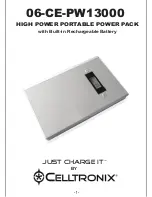
Do not drop or
throw the tool.
Dropping or throwing the tool can
result in damage that will make the tool
unusable or unsafe. If the tool has been
dropped or thrown, examine the tool
closely for bent, cracked or broken parts
and air leaks. STOP and repair before
using or serious injury could occur.
Clean and check all
air supply hoses
and fittings before connecting the
tool to an air supply. Replace any
damaged or worn hoses or fittings.
Tool performance or durability may be
reduced.
sErvICE
a . Tool service must be performed only
by qualified repair personnel.
b . When servicing a tool, use only
identical replacement parts. Use
only authorized parts.
c . Use only the lubricants supplied
with the tool or specified by the
manufacturer.
Do not make any
modifications to
the tool without first obtaining written
approval from Campbell Hausfeld. Do
not use the tool if any shields or guards
are removed or altered. Do not use the
tool as a hammer. Personal injury or
tool damage may occur.
aIr soUrCE
a . Never connect to an air source that
is capable of exceeding 200 psi.
Over pressurizing the tool is able
to result in bursting, abnormal
operation, breakage of the tool or
serious injury to persons . Use only
clean, dry, regulated compressed air
at the rated pressure or within the
rated pressure range as marked on
the tool . Always verify prior to using
the tool that the air source has been
adjusted to the rated air pressure or
within the rated air-pressure range .
b . Never use oxygen, carbon dioxide,
combustible gases or any bottled
gas as an air source for the tool.
Such gases are capable of explosion
and serious injury to persons .
Tool UsE anD CarE
a . Use clamps or another practical way
to secure and support the workpiece
to a stable platform. Holding the
work by hand or against the body is
unstable and is able to lead to loss
of control .
b . Do not force the tool. Use the
correct tool for the application . The
correct tool will do the job better
and safer at the rate for which the
tool is designed .
c . Do not use the tool if the switch
does not turn the tool on or off. Any
tool that cannot be controlled with
the switch is dangerous and must be
repaired .
d .
Disconnect the
tool from the air
source before making adjustments,
doing tool maintenance, clearing
jams, leaving work area,loading,
or unloading the tool.
Such
precautionary measures reduce the
risk of injury to persons .
e . Store the tool when it is idle out
of reach of children and other
untrained persons. A tool is
dangerous in the hands of untrained
users .
f . Maintain the tool with care. Keep
a cutting tool sharp and clean . A
properly maintained tool, with sharp
cutting edges reduces the risk of
binding and is easier to control .
g . Check for misalignment or binding
of moving parts, breakage of parts,
and any other condition that affects
the tool’s operation. If damaged,
have the tool serviced before using .
Many accidents are caused by poorly
maintained tools . There is a risk of
bursting if the tool is damaged .
h . Use only accessories that are
identified by the manufacturer for
the specific tool model. Use of an
accessory not intended for use with
the specific tool model increases the
risk of injury to persons .
i . Selecting an appropriate tool
actuation system, taking into
consideration the work application
for which the tool is used .
Never use
gasoline
or other flammable liquids
to clean the tool. Never use
the tool in the presence of
flammable liquids or gases. Vapors
could ignite by a spark and cause an
explosion which will result in death or
serious personal injury.
Do not exceed
maximum operating
pressure of the air tool (90 psi). The air
tool could explode and result in death
or serious personal injury.
Do not use hand
tool sockets. Use
impact quality sockets only. Hand
tool sockets are “glass-hard” and will
shatter and can cause serious personal
injury if used with air tools.
j . Never trigger the tool when
not applied to a work object .
Attachments must be securely
attached . Loose attachments can
cause serious injury .
Release all pressure
from the system
before attempting to install, service,
relocate or perform any maintenance.
k . Keep all nuts, bolts and screws tight
and ensure equipment is in safe
working condition .
Always disconnect
the tool from
the power source when unattended,
performing any maintenance or repair,
clearing a jam, or moving the tool to a
new location.
Always fit tool
with a fitting or
hose coupling on or near the tool in
such a manner that all compressed air
in the tool is discharged at the time the
fitting or hose coupling is disconnected.
Do not use a check valve or any other
fitting which allows air to remain in the
tool. Death or serious personal injury
could occur.
Never carry the tool
by the air hose
or pull the hose to move the tool or
a compressor. Keep hoses away from
heat, oil and sharp edges. Replace any
hose that is damaged, weak or worn.
Personal injury or tool damage could
occur.
Do not operate or allow
anyone else to operate
the tool if any warnings
or warning labels are not legible.
Warnings or warning labels are located
on the tool magazine and body.
3
Tl0502
Important safety Instructions
(Continued)
!
WARNING
www.chpower.com




































